A World of Fairy Tale Sculptures
Artist Gerit Grimm has won international renown for her work on display at MOWA.
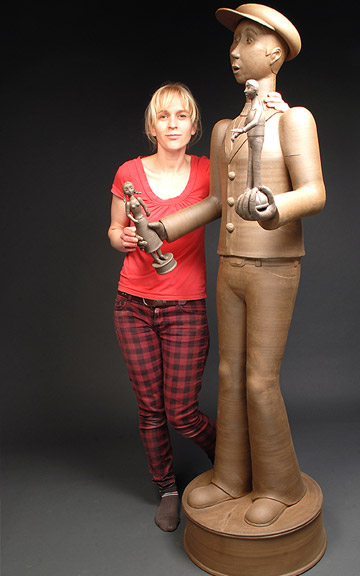
Gerit Grimm standing next to the peddler of The Peddler and Female Shopper, Stoneware, 2011. Photo from MOWA.
You might call them Grimm’s fairy tales.
Artist Gerit Grimm creates her own fanciful narratives and characters inspired by fairytales, mythology, and religion, in making her unique ceramic sculptures. Trained in pottery in East Germany prior to the collapse of the Berlin Wall, Grimm began her quest to become an artist by mastering tradition, becoming disillusioned with its limitations, and then moving on to exploring new ways of using her medium. While Grimm’s work has been displayed and recognized internationally, she continues to teach ceramics at UW-Madison and is represented locally by Tory Folliard Gallery in the Third Ward. She currently has a major show, “Gerit Grimm Fairytales: A Time Neither Here Nor There”, at the Museum of Wisconsin Art (MOWA) in West Bend through January 14th. Urban Milwaukee asked her some questions about her past and what this new body of work means in the context of her career.
Q: How old were you when you left Germany?
A: 28. I was ready to leave, I moved with a single suitcase and gave all of my belongings away. I knew wherever my heart would be I would feel happy and at home. I did have very rough eight month adjustment period; I was not myself at first and I had to relearn everything in a slow painful way. Now I admire Europe for its human principles and culture, but there, I wouldn’t have come as far as I have in the United States.
Q: And what was it like living as an artist there?
A: Raised in what was then the German Democratic Republic, I had the privilege of being classically trained as a production potter and worked as a journeyman for notable German craftsmen. Utilizing traditional ceramic craft processes, I have developed an innovative and distinct approach to making sculpture with wheel-thrown parts, and my work seeks to render the formless material of clay into figurative tableaus that push the physical limits of clay.
Q: How did you first get interested in art and when did you first consider yourself an artist?
A: I was introduced to craft early in my childhood through my parents’ modest collection of affordable folk art, dolls and pottery. I especially admired my mom’s pottery collection and used to steal cookies from a jar that was as big as I was. When I was four years old, it happened that I broke my mom’s favorite vase. Dad rescued me from her wrath, but from that day, I was fated to become a potter. When I look back at my childhood, it seems to be a fairytale. We visited castles, theaters and listened to Baroque music. I kept drawing and creating, and around the age of ten, I started to fool around with clay. We had only one wheel for the entire class, but my teacher prohibited all of us from using it except for one boy. Deprived of the object of my heart’s desire, I vowed to become a potter one day. I took art classes every day. I skipped high school art classes to bike nine kilometers to take pottery classes in a little village outside of town instead. By the time I was 18, I became an apprentice at a production pottery for three years and a journeyman for one year—being paid per piece. During this time, every evening after work, I took countless ceramic, figure drawing and painting classes.
Q: Did you have any mentors that impacted your growth?
A: I chose Margit Kovacs (1902-1977) and Valley Whieselthier as mentors even though they were dead. I read about them and studied their work. While Kovacs is known in certain decorative arts circles, there are relatively few examples of her works in public collections outside of Hungary, and a main source of my research was studying her throwing, hand-building, carving and glazing techniques by viewing her works firsthand in the Margit Kovacs Museum. I visited her museum at three different times. Since I was twelve years old I have been greatly admired her work as a ceramicist and I knew that her museum was just outside of Budapest and only 80 kilometers from Kecskemet, Hungary. Years later, in 2014 I took part as one of the featured artists in the symposium, New Energy, at the International Ceramics Studio located in the town of Kecskemét. The International Ceramics Studio has emerged as one of the leading work centers for international collaboration in the field, through their process of providing leading ceramists from different parts of the world with time and space to develop new works. Six of my best pieces where chosen for the permanent collection of the Kecskemét studios by the residency’s director, Zsolt Szegedi.
Q: What artists most inspire or influence you today?
A: The list is very long, but at this moment, my interests lie particularly in the Baroque Period, the Renaissance, and Antiquity. These particular periods represents highest level of rendering of the human figure, and the highest level of skilled craftsmanship in execution.
A: Since I run the Ceramics Program at UW-Madison I’m especially happy to have exposure in Wisconsin. The MOWA exhibition is a nice collection of my best, biggest and several not-yet-shown works from the past seven years. I view it as a mid career show since professionally it’s now 25 years that ceramics have kept my interest. I favor ceramic before all other mediums. Ceramic is a fantastic medium with endless shapes and forms. One can make it look soft or hard, depending on how the clay is worked. Applying glazes and colors can change the atmosphere one is trying to achieve. Ceramics is a challenging medium to work in and it takes years before one becomes good in using clay and glazes. I do really love living and teaching in Madison.
Q: Can you talk about the MOWA and what it has been like working with them?
A: They are wonderful, they spoiled me. MOWA staff visited and contacted me often in my Madison Studio. They were kind and supportive. The members of MOWA seemed very keen to learn about my works. Many visitors told me that they had been several times at the museum to see my exhibit.
Q: You have been described as a “non-traditional ceramist.” Would you agree or disagree with this statement?
A: Remember my chosen mentors. As women working in the early to mid-twentieth century they were pioneers in developing new ways of working in ceramic materials, and extending the traditional process of wheel throwing from its utilitarian base into a tool for the production of figurative sculpture. Their work actually predates the work of such American artists as Peter Voulkous who is typically celebrated as an innovator in ceramics—transforming it from a craft-based practice into fine art.
Q: How do fairy tales and mythology play a factor in your work?
A: My work appropriates historical subjects deriving from fables and myths, and I interpret them in forms that have visual and conceptual affinities with contemporary fine art—affinities that allow me to further explore and question the boundaries between pop art, kitsch and high art. My reinterpretation of these traditions combines metaphor, narrative and form—synthesizing pots with myths and fairytales in a way that tests the boundaries of each. The result is often an uncanny union—one that evokes all manner of stories about dolls, puppets and statues coming to life.
Q: How much preliminary work goes into creating a sculpture before you actually start sculpting?
A: I do background research for each new body of work by attending schools like Florence Academy of Art (Italy) in July 2015 were I worked intensively to improve my techniques for realistically sculpting figures. In my new work I‘m excited to explore the fascinating and endless stories of Greek mythology and ancient Greek literature (e.g. the Iliad, The Odyssey), which will give me the opportunity to explore characters, introduce idealization and portraiture into my work. I’m looking forward to create these half-rock half-human sculptures.
To undertake my 2017 research I visited art museums in Milan and Venice, studying depictions of pietas, lamentations, entombments, crucifixions; the Venice Biennial; attended The Women Working in Clay Symposium; studied at the Birmingham Museum and Tate Britain in London. My 2018 research of historical garments would include studying sculptures, paintings and theater performances at multiple European art museums, costume collections and theaters in France (Louvre), Spain, Czech (The Slav Epic by Alphonse Mucha), Russia (Hermitage) and the United States (FIDM in Los Angeles, CA, which exhibits garments used for theater and film). I search for inspiration from different nations by traveling to different world art collections to study painting and sculpture to see how garments shape appearances, how they hang and move on the human body, and how they can illustrate stories and customs in my figurative scenes, adding layers of meaning and depth.
Q: What do you like or dislike about the current art scene?
A: I’m more interested in art history and the past in representational figurative and realist art, but I do appreciate many works, which are created nowadays. I like many styles. I love going to the Biennial in Venice and I must say the art sometimes is not strong enough to compete with the beautiful palazzos. That really makes me smile. I prefer the past.
Q: Do you collect anything?
A: Dresses, shoes and my own unsold work.
Q: What’s your favorite work or series you have created, and why?
A: The biblical series about Death….I had to cope with my dad dying in Germany in the late summer of 2016. My father was only 75 years old, and his death was completely unexpected. I was deeply affected emotionally by this event, and I believe that it has affected my work. Losing a parent with no time to prepare emotionally is a life-altering event, and it is especially difficult when your entire family lives abroad. I felt unusually fragile and vulnerable, but the healing process has begun and I am confident of my ability to bounce back from this tragedy. I forced myself to start working again. I wanted to create figurative sculptures with layers of beauty, strength, inwardness, isolation and vulnerability, which show the many layers of death.
Q: What do you think is the biggest misconception that artists have to deal with?
A: That people think we have fun and a great times in our studios, that our job is easy. When I leave my studio I’m so exhausted — I just want to be cared for, after battling with developing my sculptures. When I work I try to ignore all distractions, I ignore my friends and family…and then I find myself all alone when my time opens up and I need to refill with love and life experiences.
Artwork by Gerit Grimm
Art
-
Winning Artists Works on Display
 May 30th, 2024 by Annie Raab
May 30th, 2024 by Annie Raab
-
5 Huge Rainbow Arcs Coming To Downtown
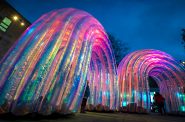 Apr 29th, 2024 by Jeramey Jannene
Apr 29th, 2024 by Jeramey Jannene
-
Exhibit Tells Story of Vietnam War Resistors in the Military
 Mar 29th, 2024 by Bill Christofferson
Mar 29th, 2024 by Bill Christofferson

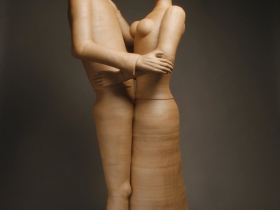
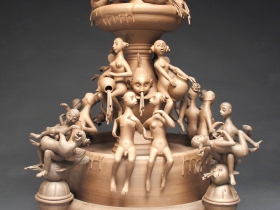
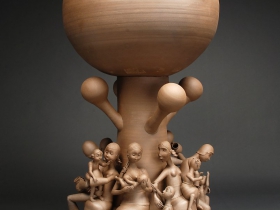
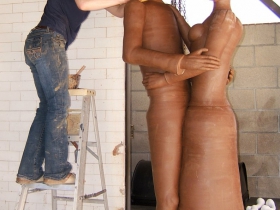
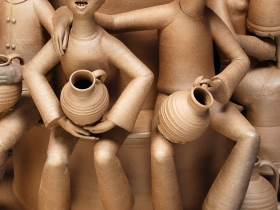
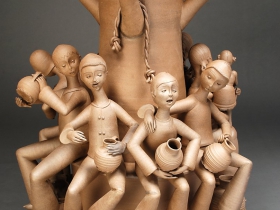



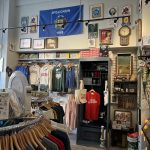
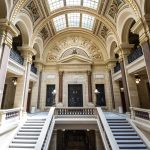














I love going to the Biennial in Venice and I must say the art sometimes is not strong enough to compete with the beautiful palazzos. That really makes me smile.
Nice.